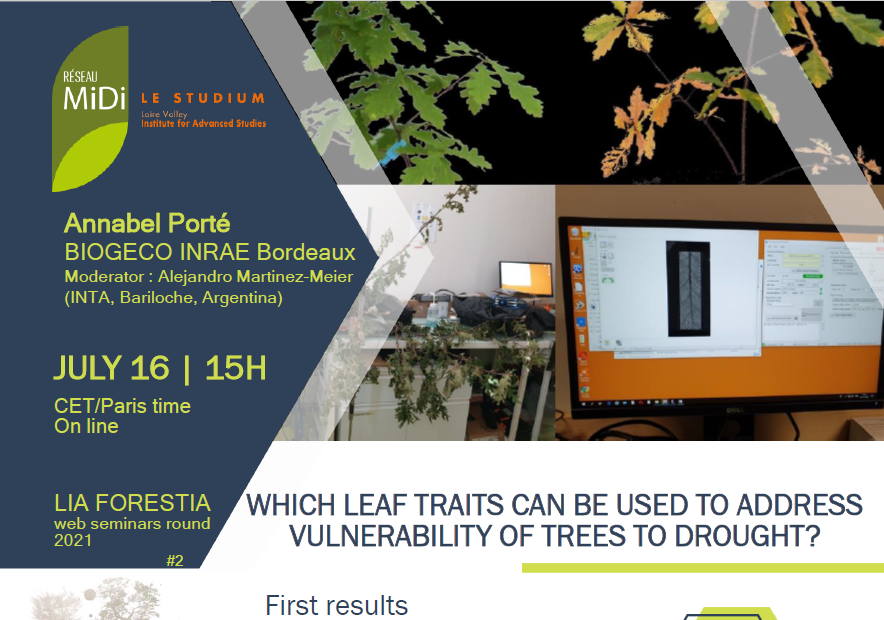This seminar round is organized within the framework of the activities of the LIA FORESTIA (International Associated Laboratory FORESTIA) and the MiDi network with the support of the Studium.
Round of FORESTIA web seminars
SEMINAR # 2
WHICH LEAF TRAITS CAN BE USED TO ADDRESS VULNERABILITY OF TREES TO DROUGHT?
First results
Annabel Porté (BIOGECO, INRAE Bordeaux)
JULY 16 at 15h (CET/Paris time)
The International Associated Laboratory FORESTIA starts in 2021 a new round of short seminars aimed at stimulating the scientific comunication among its members, as well as between them and other international laboratories. These seminars are a new opportunity for the FORESTIA scientists to present and discuss their objectives, research work and results on adaptation of forest ecosystems to global changes.
Abstract
Studies on climate change for 2050 predict for South-West France an increase in precipitation during the winter, but a strong reduction in summer (Dayon et al. 2015) with in the long term (2100), a change in the type of climate at the regional level, shifting towards a mediterranean-like climate with hot and dry summers (Beck et al. 2018). These changes are already leading to an increase in summer droughts and heat waves both in number and severity (Spinoni et al. 2014).
The vulnerability to drought of trees has been related to the vulnerability of xylem to cavitation (Brodribb et al. 2010). It thus appears as a useful trait to evaluate species at risk in the future. For instance, at the southern limit of its distribution area in the Aquitaine plain, xylem cavitation vulnerability of Quercus robur results in a null hydraulic safety margin under current summer drought conditions, and suggests a local decline under future climate (Urli et al. 2013, 2014).
We are testing several methodologies to characterize leaf traits on trees submitted to drought. Vulnerability to cavitation can be achieved on stems but also leaves using the Optic Technic (Brodribb et al. 2015) although the method is still limited depending on vessel length. Indicators related to leaf functioning were also tested using changes in fluorescence measurements and leaf coloration in response to drought.
Moderator: : Alejandro Martinez Meier (INTA, Bariloche, Argentina)
Free registration on LIA FORESTIA WEBINAR #2
Registration required to receive the connection link
MiDi is a interdisciplinary Research Thematic Network, focused on biodiversity and habitats and funded by the Centre-Val de Loire Region. The network aims to promote studies in multiple fields of BioGeoSciences and Human and Social Sciences in relation to global changes.
This conference is organised in partnership with the Le Studium (Institute for Advanced Studies).
These round of FORESTIA web seminars will take place Fridays every four weeks, starting on the 4th of June 2021.
>> Next seminar on July 30 by Guillermina Dalla-Salda (INTA Bariloche (IFAB INTA-CONICET)
Contact :
alexia.soussen@univ-tours.fr


